Like a delicate flower blooming in the wild, Miltoniopsis orchids require special care to flourish and reach their full potential. With proper maintenance, these beautiful plants can be an exquisite addition to any home and bring years of joy. This guide will provide knowledge essential for cultivating healthy Miltoniopsis orchids so that they can thrive in your environment.
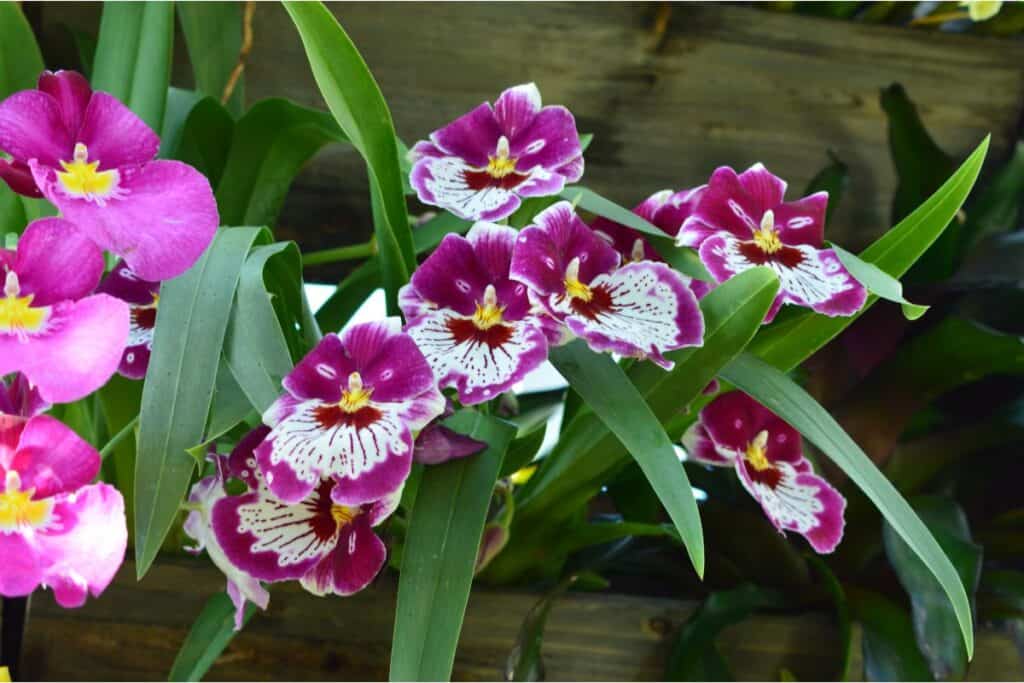
When it comes to taking care of Miltoniopsis Orchids, there is much more than meets the eye. In order to ensure success with this type of species, one must understand its unique needs and how to satisfy them. From providing suitable temperature conditions to choosing the right soil mixes; each element plays a crucial role in keeping your plant happy and healthy.
The good news is that you don’t have to be an expert horticulturist to master Miltoniopsis care! All it takes is some basic understanding of what these flowers need from their environment, as well as patience and dedication – both traits of successful gardeners! So buckle up – we are about to embark on a journey toward creating the perfect habitat for our beloved orchid friends!
Contents
- 1 Lighting Requirements For Miltoniopsis
- 2 Temperature Requirements For Miltoniopsis
- 3 Humidity Requirements For Miltoniopsis
- 4 Substrate And Potting Media For Miltoniopsis
- 5 Watering Miltoniopsis
- 6 Feeding Miltoniopsis
- 7 Potting Miltoniopsis
- 8 Dealing With Pests On Miltoniopsis
- 9 Understanding Miltoniopsis Blooming Cycles
- 10 Selecting The Right Container For Miltoniopsis
- 11 Creating The Ideal Growing Environment For Miltoniopsis
- 12 Repotting And Transplanting Miltoniopsis
- 13 Enhancing Color And Form Of Miltoniopsis
- 14 Combating Common Miltoniopsis Diseases
- 15 Maximizing The Lifespan Of Miltoniopsis
- 16 Conclusion
Lighting Requirements For Miltoniopsis
Lighting is one of the most important aspects of successful Miltoniopsis care. It’s like the sun giving life to a garden – without it, your orchids will droop and die as if they were wilting in the shadows.
When it comes to lighting requirements for Miltoniopsis, medium light is ideal. If you don’t have access to natural sunlight through south-facing windows, then there are plenty of artificial lights on the market that can provide them with an adequate source of bright light. Make sure to adjust the distance between the plants and the lights regularly so that their leaves do not scorch from too much heat. Remember: even indirect sunlight should be monitored closely!
Miltoniopsis need at least 12 hours of darkness in order to thrive, but more than 14 hours might cause flowering issues. Therefore, it’s best to find a balance that works well for both you and your plants; this way, everyone stays happy and healthy!
Temperature Requirements For Miltoniopsis
When it comes to caring for Miltoniopsis, the temperature is an important factor. These orchids prefer warmer temperatures than many of their relatives and require the right environment in order to stay healthy.
Miltoniopsis need temperatures between 68-75 degrees Fahrenheit during the day and slightly cooler at night—ideally around 10 degrees lower than daytime temperatures. To make sure these conditions are met, investing in a thermometer with a hygrometer might be beneficial if you don’t have one already. This way, you’ll always know what’s going on inside your orchid’s home! Ensuring that your Miltoniopsis has the proper temperature requirements will make all the difference when it comes to its health and beauty.
Humidity Requirements For Miltoniopsis
Understanding the humidity requirements for Miltoniopsis is essential to keeping your orchid healthy and happy. These plants thrive in high levels of moisture, so providing adequate humidity is paramount! Here are some tips to ensure you’re meeting their needs:
- Aim for an average relative humidity between 60%-80%.
- Consider using a humidity tray with stones and water beneath the pot to increase ambient moisture if needed.
- Use a hygrometer (humidity meter) to monitor your levels daily.
- Give extra humidity during summer months when air conditioning can reduce indoor levels significantly. It’s important not to let the soil dry out completely; this will cause stressed plants that struggle to flower or have poor root health, as well as increasing susceptibility to disease and pests. By monitoring your plant’s environment closely, you’ll be able to keep it thriving all year round!
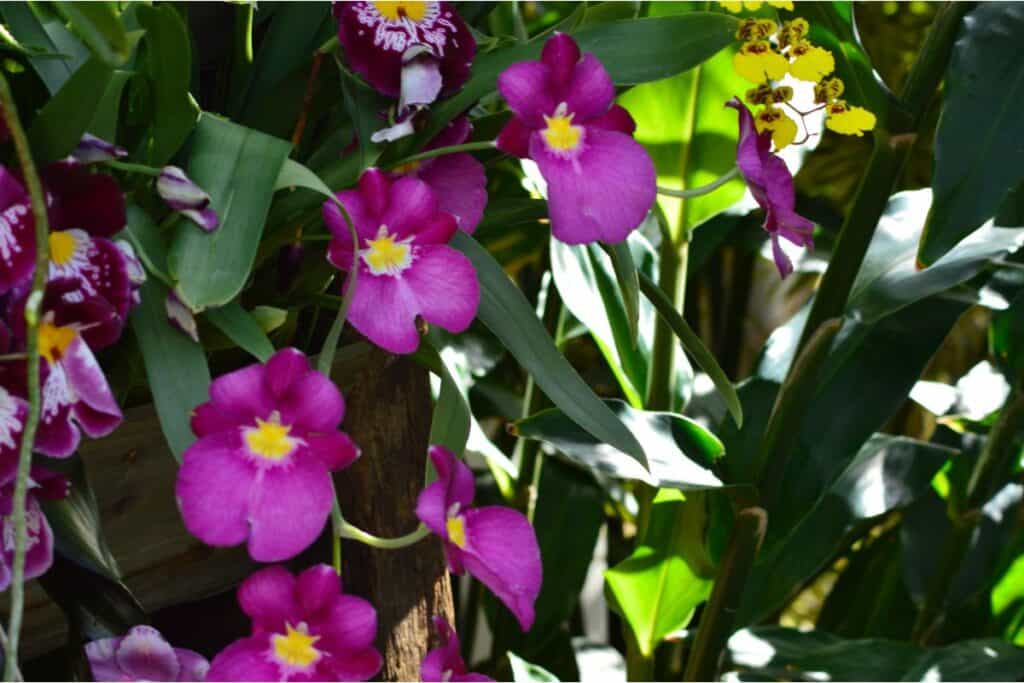
Substrate And Potting Media For Miltoniopsis
It is estimated that nearly 80% of orchids die within a year due to improper substrate and potting media. When it comes to Miltoniopsis, choosing the right substrate and potting medium can be quite daunting as they are quite sensitive when it comes to growing in different conditions.
For this particular type of orchid, sphagnum moss is an ideal option for its roots as it helps retain moisture while providing enough air circulation. You may also choose pine bark which has excellent drainage properties but does not hold onto water for long periods of time; thus, you will need to ensure that your plant gets adequate hydration by misting frequently. If you’re looking for something simpler, then potting mix would work best; however, make sure that it contains peat moss and perlite or coarse sand so that there is good aeration.
Overall, Miltoniopsis needs proper care when it comes to selecting substrate and potting media – if done correctly, these tiny flowers will bring plenty of joy!
Watering Miltoniopsis
Watering your Miltoniopsis is an important step in keeping them healthy and looking good. Providing the orchid with enough water, but not too much, can be tricky. You’ll want to use unfertilized tap water when watering your Miltoniopsis – it’s just as easy as using other types of water and will provide all the nutrients they need.
When you’re ready to give your Miltoniopsis a drink, make sure their potting medium is damp before adding more water; this helps prevent root rot, which could quickly kill off the plant. Water thoroughly so that the entire container becomes wet and then wait until most of the excess moisture has drained away before placing back on its saucer. Do this every 7-10 days and you should see great results!
Feeding Miltoniopsis
Feeding Miltoniopsis is an important part of their culture, but it’s also easy to overdo it. With proper care and attention, you can ensure your orchid gets the nutrition they need without over-fertilizing.
When feeding Miltoniopsis, start with a balanced fertilizer that contains minor elements like calcium and magnesium in addition to macronutrients such as nitrogen, phosphorous, and potassium. You’ll also want to add sphagnum moss for extra moisture. The moss should be slightly moistened each time it’s added so that the roots don’t dry out too quickly. For best results, use distilled water when watering your Miltoniopsis; tap water tends to contain minerals that can build up in the potting medium over time and affect plant health negatively.
Fertilize once a month during active growth periods when temperatures are warm enough for plants to grow (above 60° F). Once a season is usually sufficient during colder months. Monitor nutrient levels closely by checking soil composition regularly and adjusting accordingly depending on how much growth has occurred since the last application—too little fertilizer will stunt growth while excess nutrients can cause damage, leading to stunted blooms or other problems down the line.
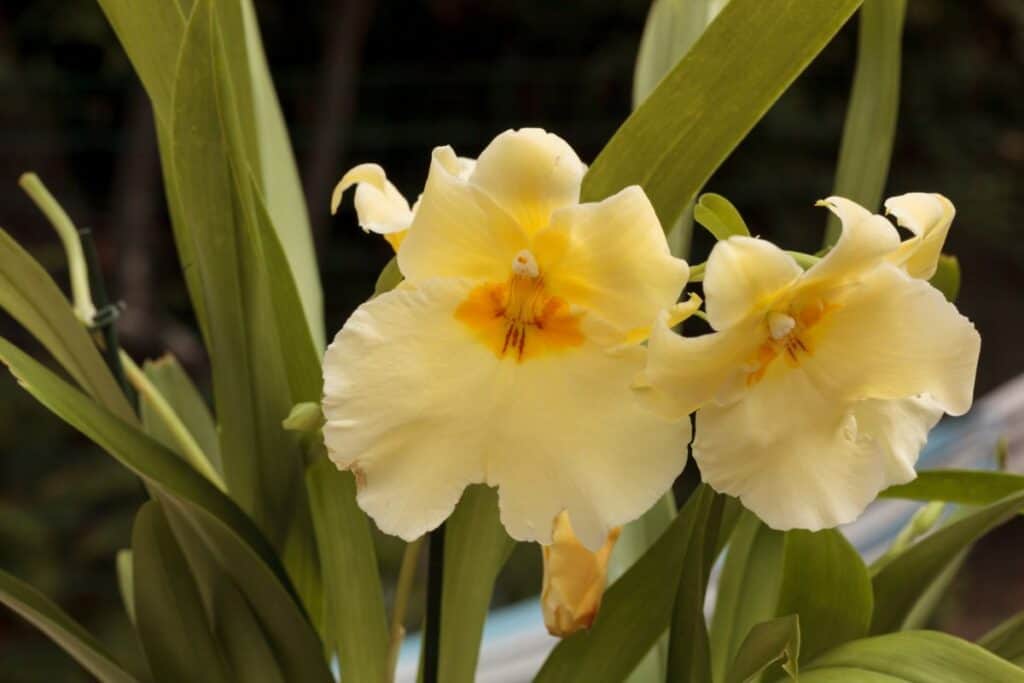
Related Post:
Miltonia vs Miltoniopsis (Similarities & Differences)
Potting Miltoniopsis
Potting Miltoniopsis is like putting together a puzzle. With the right pieces and skill, you can create an atmosphere that will keep your orchid happy and healthy for years to come. When potting Miltoniopsis, remember that they hail from South America where it’s humid and warm year-round. You’ll need to recreate similar conditions in order to give them the best chance at thriving. Make sure you are using well-draining soil with good aeration; this helps prevent mineral buildup which can be fatal for these delicate blooms.
Be sure to repot every two years, but wait until the medium has dried out completely – bone dry! This allows any unwanted pests to die off before propagating them into their new home. Also make sure there’s enough room around the roots so they don’t become soggy or rot due to lack of air circulation. These steps will ensure Miltoniopsis care stays top-notch!
Dealing With Pests On Miltoniopsis
Dealing with pests on Miltoniopsis is an important part of the plant’s care. When it comes to ensuring a healthy and happy living environment for your orchid, you’ll want to be proactive about pest control. To do this, start by regularly inspecting your plants for any signs of bacterial growth or infestations from common pests like mealybugs, scale insects, aphids, thrips and fungus gnats.
Fortunately, there are some simple steps you can take to prevent these kinds of issues from occurring in the first place:
- Cleaning away dead leaves or flower stems that may have fallen off during pruning;
- Regularly misting your Miltoniopsis’ leaves – especially when grown indoors;
- Adding sphagnum moss around the base of the potting mix as an extra layer of protection;
- Keeping up with regular watering schedules while avoiding over-watering; and
- Ensuring adequate air circulation by providing ample space between other plants nearby.
By following these tips outlined in our Miltoniopsis care sheet, you should easily be able to keep pests at bay so you can enjoy watching your beloved orchids thrive!
Understanding Miltoniopsis Blooming Cycles
As the old adage goes, “You can’t rush nature.” And this is certainly true of Miltoniopsis orchids when it comes to blooming cycles. Understanding these seasonal fluctuations will help you care for your plant with confidence.
The Miltoniopsis orchid typically blooms in the cooler months. These flowers are quite unique as they come in a range of colors from deep purple and pink to white and yellow. When caring for your Miltoniopsis, there are two main things to consider: temperature and water requirements. During the winter months, keep temperatures around 60-65°F (15-18°C). Make sure not to let them get too cold, however! Additionally, make sure that you’re only giving your plants just enough water so their soil stays damp but not soggy.
To ensure healthy growth, here are some tips:
- Temperature:
- Keep temperatures between 60 – 65°F during the colder months
- Avoid letting them get too cold
- Water Requirements:
- Only give plants just enough water
- Soil should remain damp but never soggy
By following these simple guidelines, you can rest assured that your Miltoniopsis flower will bloom beautifully throughout each season. With proper care and maintenance, any gardener can enjoy watching their beautiful flowers flourish year after year.
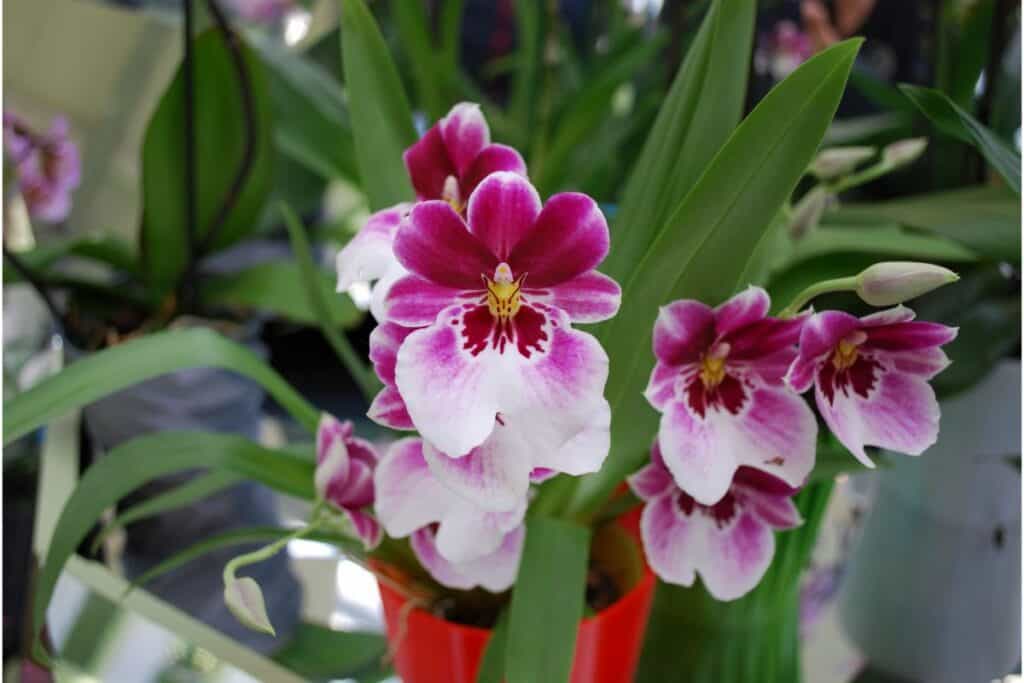
Selecting The Right Container For Miltoniopsis
Selecting the right container for Miltoniopsis is an important step in ensuring that your plant will thrive and bloom. When selecting a pot, it’s best to use one with drainage holes so that excess water can escape. The ideal medium for Miltoniopsis consists of a mix of small sized bark and fir bark, as this helps retain moisture while allowing air to circulate around the roots.
When filling the pot, make sure not to overfill it with soil; leave some room at the top so that you don’t end up burying your orchid too deeply. If possible, try to find containers that are slightly larger than what is recommended for other orchids since these plants tend to have more extensive root systems.
TIP: Miltoniopsis need good air circulation and humidity levels in order to thrive. To maximize both of these factors, avoid using plastic pots and opt instead for clay or terracotta containers which allow air flow through their walls.
Creating The Ideal Growing Environment For Miltoniopsis
Creating the ideal growing environment for Miltoniopsis is like building a house: it requires patience, attention to detail and lots of love. When setting up the perfect Miltoniopsis habitat, there are three main factors to consider – humidity, temperature and sphagnum moss – all of which should be carefully managed in order to create a safe home for your plant.
Humidity is one of the most important elements when it comes to cultivating healthy Miltoniopsis plants. Aiming for around 70% year-round will give your orchid just enough moisture without being too wet. If you’re unable to monitor the humidity with an indoor device, try adding some sphagnum moss on top of the potting soil or even surrounding the pot itself as this can help keep things moist. Additionally, gently misting their leaves once per day can also help maintain appropriate levels of hydration.
Temperature is another crucial factor when caring for Miltoniopsis indoors; during the summer months aim for temperatures between 18-20°C while in winter they prefer cooler conditions (around 16°C). It’s important not to let them get too cold however so if possible keep them somewhere away from any draughts that could harm their delicate petals. With these two elements properly balanced, your Miltoniopsis plants will have everything they need for growth and blooming success!
Repotting And Transplanting Miltoniopsis
Repotting and transplanting Miltoniopsis is a crucial part of keeping this tropical orchid healthy. The process can seem intimidating, but with the right preparation it’s an easy task that will bring you closer to your plant friends!
To begin the process, start by gathering materials such as potting soil, sphagnum moss, and a larger planter. It’s important to use these specific ingredients: potting soil provides essential nutrients for your orchids, while sphagnum moss acts like a sponge to help retain moisture in their roots. Once you have all the necessary supplies, take out your Miltoniopsis from its current home and prepare for repotting or transplanting.
When handling your Miltoniopsis during the procedure, be sure to exercise extra caution since any wrong move could damage its fragile structure. Make sure that you are gentle when transferring it into its new environment — using gloves may also prove helpful if needed. When adding in the potting soil and sphagnum moss, make sure not to overfill; otherwise your orchids won’t receive proper drainage which could lead to root rot. After everything is set up properly, give them some time to adjust before resuming regular caretaking routines.
By following these steps carefully when repotting and transplanting Miltoniopsis, you’ll ensure they stay happy and healthy so they can continue bringing life and beauty into your space!
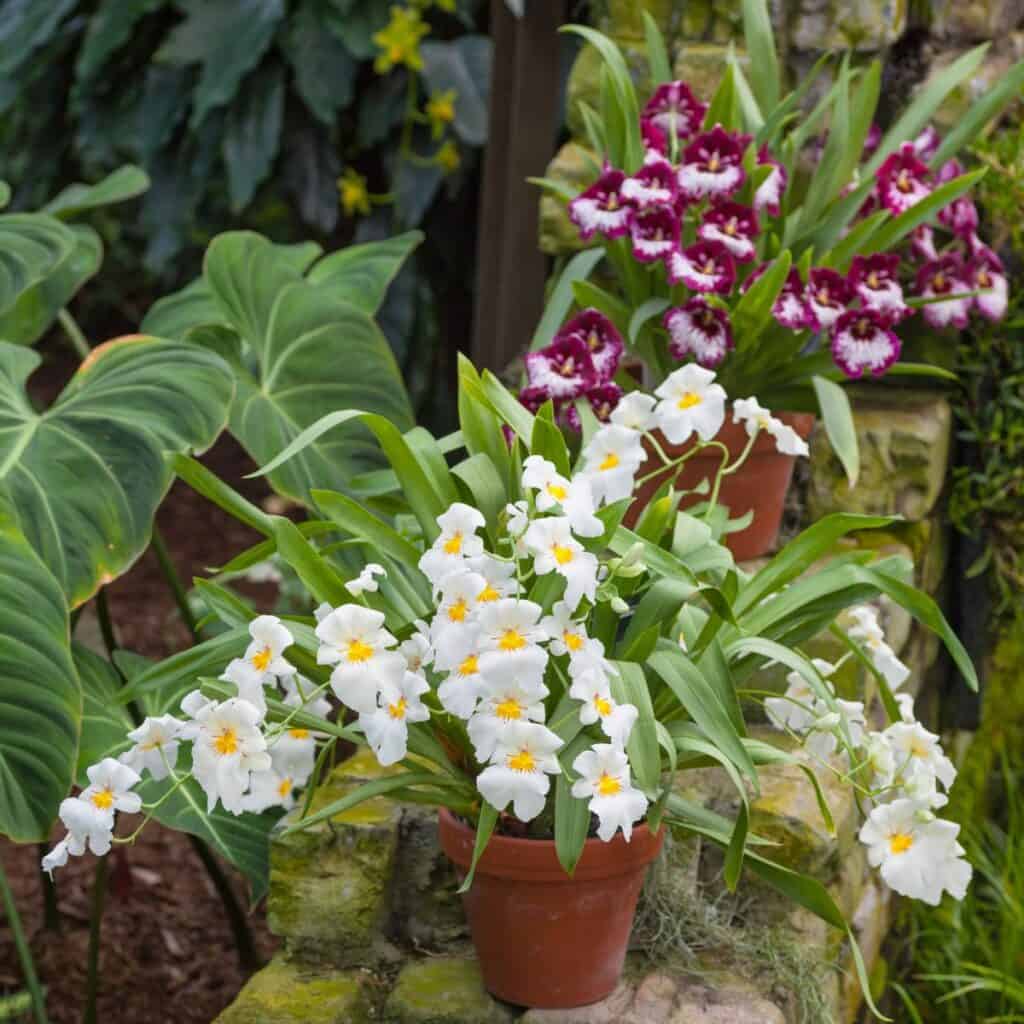
Enhancing Color And Form Of Miltoniopsis
Have you been wanting to take your Miltoniopsis vexillaria care up a notch? Enhancing the color and form of this gorgeous flower is achievable with some extra attention.
First, it’s important to understand how to properly handle the accordion-like pleated leaves as they are delicate. When repotting or transplanting, use a dressing of sphagnum moss for added protection against any shock from moving them into new soil mixtures. It’s also essential that there be enough air space around the roots – too much media can lead to root rot which will eventually kill the plant.
Fertilizing regularly with an orchid fertilizer specifically designed for epiphytic orchids like Miltoniopsis is another key step in keeping these plants looking their best. By following all of these steps, you should begin seeing brighter colors and more vivid forms within weeks!
Combating Common Miltoniopsis Diseases
At first glance, it may seem like Miltoniopsis care is all about ensuring the right environmental conditions – and while this is certainly important, there are other factors to consider too. One of these factors is disease prevention; combating common diseases can be essential for long-term success with Miltoniopsis orchids.
Root growth, relative humidity, and thicker leaves are three key elements in preventing disease from taking hold. For example, when root growth is healthy then nutrients will be more readily available to the plant which helps strengthen its natural defenses against disease. The same goes for keeping up a proper level of relative humidity – if the air surrounding your Miltoniopsis is too dry, then it won’t have the ability to effectively fend off any unwanted visitors looking to cause problems! Finally, having thicker leaves means that your orchid can better protect itself from external threats such as pests and pathogens.
By practicing good cultural practices and understanding how different elements work together to create a strong foundation for healthful living, you’ll find that your Miltoniopsis plants remain vibrant and full of life year after year! Taking on the task of fighting back against potential diseases doesn’t have to feel daunting – just stay informed on best practices related to your specific environment so you can keep your orchids flourishing in no time at all.
Maximizing The Lifespan Of Miltoniopsis
When it comes to maximizing the lifespan of Miltoniopsis, there’s no room for error. It is an absolute necessity that you provide your plants with the needed care and attention in order to keep them healthy! Truly, when done properly, it can be like watching a miracle unfold before your eyes – they will reward you with beautiful blooms year after year if taken good care of.
Let’s start by talking about their roots; as any experienced grower knows, keeping these nourished and hydrated is key. Make sure you water your plants regularly so that the soil never fully dries out between waterings—but don’t forget to let it dry somewhat so that oxygen isn’t completely cut off from reaching their roots. This balance is paramount for active growth: too much or too little moisture can both cause harm.
Next up are other important steps in ensuring the long-term health of your plant:
- Temperature & Humidity Control: Miltoniopsis thrive best at temperatures ranging from 65°F (18°C) to 85°F (29°C). They also need humidity levels of around 70% or higher on average for optimal performance.
- Fertilizing: Feeding your Miltoniopsis every two weeks during its growing season is essential; this helps promote strong root development and abundant flowers over time.
These small but crucial details go a long way towards creating a safe and stable environment where your plant can flourish – one that meets all their needs not just today, but well into the future. By following these guidelines faithfully, Miltoniopsis homeowners can look forward to having many years of enjoyment ahead of them!
Conclusion
In conclusion, taking proper care of Miltoniopsis is essential to ensuring they survive and thrive. With just a little bit of effort, you can enjoy their vibrant blooms for years to come! According to the American Orchid Society, orchids as a whole are among the longest-living houseplants in existence; some species have been known to live up to 50 years or more with proper care. So if you take your time and follow the right steps when caring for Miltoniopsis, you’ll be able to happily watch them grow over many years.
I hope this guide has given you a better understanding on how to give your Miltoniopsis all the attention it needs. From providing the correct lighting and temperature conditions, to selecting the appropriate potting media and substrate – there’s plenty of factors that should go into growing these beautiful plants successfully. You now have all the information necessary to get started – so what are you waiting for? I’m sure your Miltoniopsis will thank you later when it’s thriving from all your hard work!
